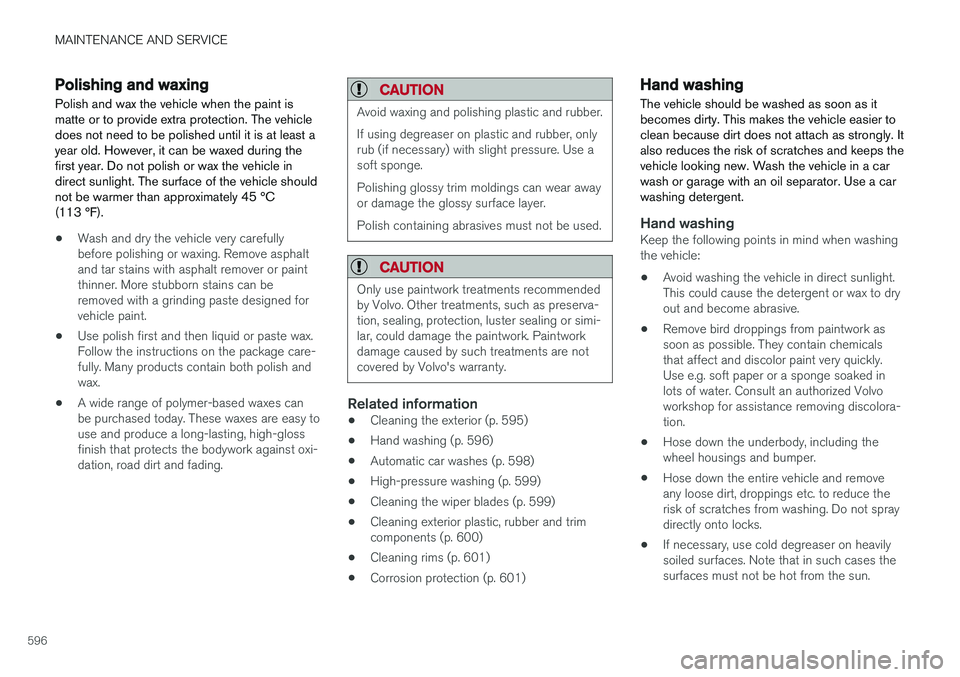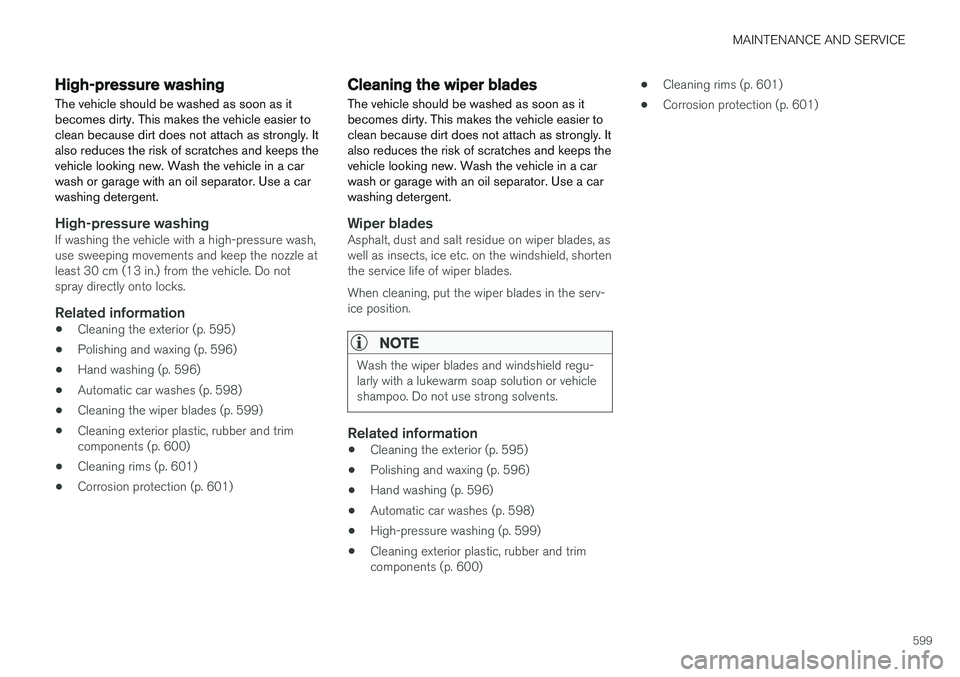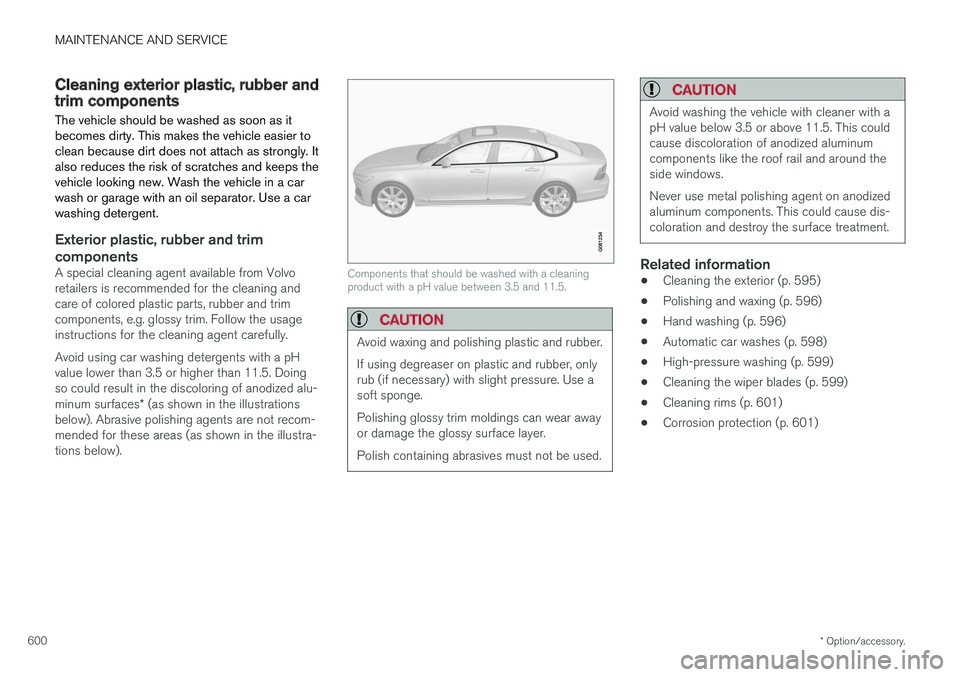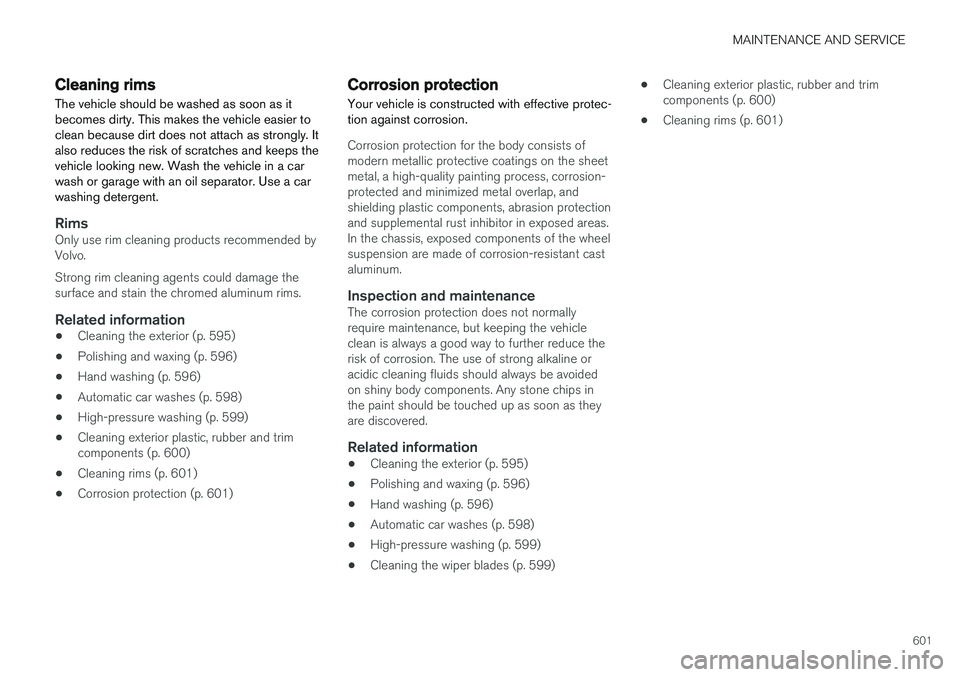2018 VOLVO S90 wiper blades
[x] Cancel search: wiper bladesPage 598 of 640

MAINTENANCE AND SERVICE
596
Polishing and waxingPolish and wax the vehicle when the paint is matte or to provide extra protection. The vehicledoes not need to be polished until it is at least ayear old. However, it can be waxed during thefirst year. Do not polish or wax the vehicle indirect sunlight. The surface of the vehicle shouldnot be warmer than approximately 45 °C(113 °F).
• Wash and dry the vehicle very carefully before polishing or waxing. Remove asphaltand tar stains with asphalt remover or paintthinner. More stubborn stains can beremoved with a grinding paste designed forvehicle paint.
• Use polish first and then liquid or paste wax.Follow the instructions on the package care-fully. Many products contain both polish andwax.
• A wide range of polymer-based waxes canbe purchased today. These waxes are easy touse and produce a long-lasting, high-glossfinish that protects the bodywork against oxi-dation, road dirt and fading.
CAUTION
Avoid waxing and polishing plastic and rubber. If using degreaser on plastic and rubber, only rub (if necessary) with slight pressure. Use asoft sponge. Polishing glossy trim moldings can wear away or damage the glossy surface layer. Polish containing abrasives must not be used.
CAUTION
Only use paintwork treatments recommended by Volvo. Other treatments, such as preserva-tion, sealing, protection, luster sealing or simi-lar, could damage the paintwork. Paintworkdamage caused by such treatments are notcovered by Volvo's warranty.
Related information
•
Cleaning the exterior (p. 595)
• Hand washing (p. 596)
• Automatic car washes (p. 598)
• High-pressure washing (p. 599)
• Cleaning the wiper blades (p. 599)
• Cleaning exterior plastic, rubber and trim components (p. 600)
• Cleaning rims (p. 601)
• Corrosion protection (p. 601)
Hand washing
The vehicle should be washed as soon as it becomes dirty. This makes the vehicle easier toclean because dirt does not attach as strongly. Italso reduces the risk of scratches and keeps thevehicle looking new. Wash the vehicle in a carwash or garage with an oil separator. Use a carwashing detergent.
Hand washingKeep the following points in mind when washing the vehicle:
• Avoid washing the vehicle in direct sunlight.This could cause the detergent or wax to dryout and become abrasive.
• Remove bird droppings from paintwork assoon as possible. They contain chemicalsthat affect and discolor paint very quickly.Use e.g. soft paper or a sponge soaked inlots of water. Consult an authorized Volvoworkshop for assistance removing discolora-tion.
• Hose down the underbody, including thewheel housings and bumper.
• Hose down the entire vehicle and removeany loose dirt, droppings etc. to reduce therisk of scratches from washing. Do not spraydirectly onto locks.
• If necessary, use cold degreaser on heavilysoiled surfaces. Note that in such cases thesurfaces must not be hot from the sun.
Page 599 of 640

MAINTENANCE AND SERVICE
597
•
Wash using a sponge, car washing detergent and plenty of lukewarm water.
• Clean the wiper blades with lukewarm soapsolution or car washing detergent.
• Dry the vehicle using a clean, soft chamois ora squeegee. Try not to let drops of water dryin strong sunlight. This could cause waterdrying stains that may need to be polishedout.
• In areas with heavy industrial emissions,more frequent washing of the vehicle's exte-rior is recommended.
• Tar spots from asphalt may remain even afterwashing. Use a tar remover to remove thesespots after washing the vehicle.
WARNING
Always entrust engine washing to a workshop. If the engine is hot, there is a risk of fire.
CAUTION
Dirty headlights do not work as well. Clean them regularly, e.g. when refueling. Do not use corrosive cleaners. Use water and a non-abrasive sponge.
NOTE
Exterior lighting such as headlights and tail- lights may develop temporary condensationon the inside of the lens. This is normal. Allexterior lighting is designed to resist this.Condensation is normally vented out of thelamp housing once the light has been lit forsome period of time.
CAUTION
• Make sure that the panoramic roof and sun shade are closed before washing thevehicle.
• Never use abrasive polishing agents onthe panoramic roof.
• Never use wax on the rubber sealsaround the panoramic roof.
CAUTION
Remember to remove dirt from the drain holes in the doors and sills after washing thevehicle.
Related information
• Cleaning the exterior (p. 595)
• Polishing and waxing (p. 596)
• Automatic car washes (p. 598)
• High-pressure washing (p. 599) •
Cleaning the wiper blades (p. 599)
• Cleaning exterior plastic, rubber and trim components (p. 600)
• Cleaning rims (p. 601)
• Corrosion protection (p. 601)
Page 600 of 640

MAINTENANCE AND SERVICE
598
Automatic car washes The vehicle should be washed as soon as it becomes dirty. This makes the vehicle easier toclean because dirt does not attach as strongly. Italso reduces the risk of scratches and keeps thevehicle looking new.
Automatic car washesAn automatic car wash is a fast and easy way to keep your vehicle clean, but it does not reach allareas of the vehicle. For best results, Volvo rec-ommends hand washing your vehicle or supple-menting automatic car washes with a hand wash.
NOTE
Volvo recommends not washing the vehicle in an automatic car wash during the first fewmonths; the paintwork on new vehicles takessome time to fully harden.
CAUTION
Before driving the vehicle into a car wash, deactivate the Automatic Braking when Sta-tionary and Automatic Parking Brake Applica-tion functions. If the functions are not deacti-vated, the brake system will seize when thevehicle is stationary and the vehicle will not beable to roll.
CAUTION
For automatic car washes in which the vehicle is pulled forward on rolling wheels:
1. Before washing the vehicle, make surethat the automatic rain sensor is deacti- vated. If it is not deactivated and inadver-tently starts, the wiper arms could bedamaged.
2. To help prevent damage from the auto- matic car wash machinery, make surethat the door mirrors are folded in, anten-nas retracted or removed, and any auxili-ary lights secured.
3. Drive into the automatic car wash.
4. Turn off the "Automatic Braking when Stationary" function using the switch in the tunnel console.
5. Turn off the "Automatic Parking Brake Application" function in the center dis-play's Top view.
6. Turn off the engine by turning the start knob in the tunnel console clockwise.Hold the knob in position for at least2 seconds.
The vehicle is now ready for the automatic carwash.
Related information
• Cleaning the exterior (p. 595)
• Polishing and waxing (p. 596)
• Hand washing (p. 596)
• High-pressure washing (p. 599)
• Cleaning the wiper blades (p. 599)
• Cleaning exterior plastic, rubber and trim components (p. 600)
• Cleaning rims (p. 601)
• Corrosion protection (p. 601)
Page 601 of 640

MAINTENANCE AND SERVICE
599
High-pressure washing
The vehicle should be washed as soon as it becomes dirty. This makes the vehicle easier toclean because dirt does not attach as strongly. Italso reduces the risk of scratches and keeps thevehicle looking new. Wash the vehicle in a carwash or garage with an oil separator. Use a carwashing detergent.
High-pressure washingIf washing the vehicle with a high-pressure wash, use sweeping movements and keep the nozzle atleast 30 cm (13 in.) from the vehicle. Do notspray directly onto locks.
Related information
• Cleaning the exterior (p. 595)
• Polishing and waxing (p. 596)
• Hand washing (p. 596)
• Automatic car washes (p. 598)
• Cleaning the wiper blades (p. 599)
• Cleaning exterior plastic, rubber and trimcomponents (p. 600)
• Cleaning rims (p. 601)
• Corrosion protection (p. 601)
Cleaning the wiper blades The vehicle should be washed as soon as it becomes dirty. This makes the vehicle easier toclean because dirt does not attach as strongly. Italso reduces the risk of scratches and keeps thevehicle looking new. Wash the vehicle in a carwash or garage with an oil separator. Use a carwashing detergent.
Wiper bladesAsphalt, dust and salt residue on wiper blades, as well as insects, ice etc. on the windshield, shortenthe service life of wiper blades. When cleaning, put the wiper blades in the serv- ice position.
NOTE
Wash the wiper blades and windshield regu- larly with a lukewarm soap solution or vehicleshampoo. Do not use strong solvents.
Related information
• Cleaning the exterior (p. 595)
• Polishing and waxing (p. 596)
• Hand washing (p. 596)
• Automatic car washes (p. 598)
• High-pressure washing (p. 599)
• Cleaning exterior plastic, rubber and trim components (p. 600) •
Cleaning rims (p. 601)
• Corrosion protection (p. 601)
Page 602 of 640

MAINTENANCE AND SERVICE
* Option/accessory.
600
Cleaning exterior plastic, rubber andtrim components The vehicle should be washed as soon as it becomes dirty. This makes the vehicle easier toclean because dirt does not attach as strongly. Italso reduces the risk of scratches and keeps thevehicle looking new. Wash the vehicle in a carwash or garage with an oil separator. Use a carwashing detergent.
Exterior plastic, rubber and trim components
A special cleaning agent available from Volvo retailers is recommended for the cleaning andcare of colored plastic parts, rubber and trimcomponents, e.g. glossy trim. Follow the usageinstructions for the cleaning agent carefully. Avoid using car washing detergents with a pH value lower than 3.5 or higher than 11.5. Doingso could result in the discoloring of anodized alu- minum surfaces * (as shown in the illustrations
below). Abrasive polishing agents are not recom- mended for these areas (as shown in the illustra-tions below).Components that should be washed with a cleaning product with a pH value between 3.5 and 11.5.
CAUTION
Avoid waxing and polishing plastic and rubber. If using degreaser on plastic and rubber, only rub (if necessary) with slight pressure. Use asoft sponge. Polishing glossy trim moldings can wear away or damage the glossy surface layer. Polish containing abrasives must not be used.
CAUTION
Avoid washing the vehicle with cleaner with a pH value below 3.5 or above 11.5. This couldcause discoloration of anodized aluminumcomponents like the roof rail and around theside windows. Never use metal polishing agent on anodized aluminum components. This could cause dis-coloration and destroy the surface treatment.
Related information
• Cleaning the exterior (p. 595)
• Polishing and waxing (p. 596)
• Hand washing (p. 596)
• Automatic car washes (p. 598)
• High-pressure washing (p. 599)
• Cleaning the wiper blades (p. 599)
• Cleaning rims (p. 601)
• Corrosion protection (p. 601)
Page 603 of 640

MAINTENANCE AND SERVICE
601
Cleaning rims The vehicle should be washed as soon as it becomes dirty. This makes the vehicle easier toclean because dirt does not attach as strongly. Italso reduces the risk of scratches and keeps thevehicle looking new. Wash the vehicle in a carwash or garage with an oil separator. Use a carwashing detergent.
RimsOnly use rim cleaning products recommended by Volvo. Strong rim cleaning agents could damage the surface and stain the chromed aluminum rims.
Related information
•Cleaning the exterior (p. 595)
• Polishing and waxing (p. 596)
• Hand washing (p. 596)
• Automatic car washes (p. 598)
• High-pressure washing (p. 599)
• Cleaning exterior plastic, rubber and trimcomponents (p. 600)
• Cleaning rims (p. 601)
• Corrosion protection (p. 601)
Corrosion protection
Your vehicle is constructed with effective protec- tion against corrosion.
Corrosion protection for the body consists of modern metallic protective coatings on the sheetmetal, a high-quality painting process, corrosion-protected and minimized metal overlap, andshielding plastic components, abrasion protectionand supplemental rust inhibitor in exposed areas.In the chassis, exposed components of the wheelsuspension are made of corrosion-resistant castaluminum.
Inspection and maintenanceThe corrosion protection does not normallyrequire maintenance, but keeping the vehicleclean is always a good way to further reduce therisk of corrosion. The use of strong alkaline oracidic cleaning fluids should always be avoidedon shiny body components. Any stone chips inthe paint should be touched up as soon as theyare discovered.
Related information
• Cleaning the exterior (p. 595)
• Polishing and waxing (p. 596)
• Hand washing (p. 596)
• Automatic car washes (p. 598)
• High-pressure washing (p. 599)
• Cleaning the wiper blades (p. 599) •
Cleaning exterior plastic, rubber and trimcomponents (p. 600)
• Cleaning rims (p. 601)
Page 606 of 640

||
MAINTENANCE AND SERVICE
604It is important to use the right color.
Related information
•
Paintwork (p. 602)
• Touching up minor paint damage (p. 602)
Replacing windshield wiper blades
The wiper blades help remove water from the windshield. Along with the washer fluid, theyclean the glass and help improve visibility whiledriving. The wiper blades can be replaced.
Replacing wiper blades
Raise the wiper arms to the service position. Service position is activated/deactivated viathe function view in the center display whenthe car is stationary and the windshield wip-ers are not on. Press the button on the wiperblade attachment and pull the wiper bladestraight out, parallel with the wiper arm.
Slide in a new wiper blade until it clicks into place.
3. Check to make sure the blade is securely in place.
4. Press the wiper blade back against the wind- shield.
Wiper blades come in varying lengths.
Page 607 of 640

MAINTENANCE AND SERVICE
}}
* Option/accessory.605
NOTE
The wiper blades are different lengths. The blade on the driver's side is longer than theone on the passenger side.
Related information
•Using the rain sensor (p. 180)
• Using the windshield and headlight washers (p. 182)
• Heated windshield washer nozzles
* (p. 180)
• Using the rain sensor's memory function(p. 181)
• Filling washer fluid (p. 606)
• Windshield wipers in the service position(p. 605)
• Using the windshield wipers (p. 179)
Windshield wipers in the serviceposition
The windshield wiper blades must be in the serv- ice (vertical) position when performing certainoperations, e.g. replacing the blades.
Windshield wipers in the service position.
The windshield wipers must be in the service position when replacing, washing or lifting theblades (e.g. to scrape ice or snow from the wind-shield).
CAUTION
Before placing the wipers in service position, ensure that they have not frozen to the wind-shield.
Activating/deactivating service positionThe service position can be activated/deactivated when the vehicle is stationary and the windshieldwipers are switched off. Service position is acti-vated/deactivated via Function view in the centerdisplay:
Tap the
Wiper Service
Position button. The indicator
light in the button will illuminate when service position is acti-vated. The windshield wiperswill move to the vertical posi-tion when service position is
activated. To deactivate the service position, tap
Wiper Service Position once. The indicator light
in the button will go out when service position is deactivated.